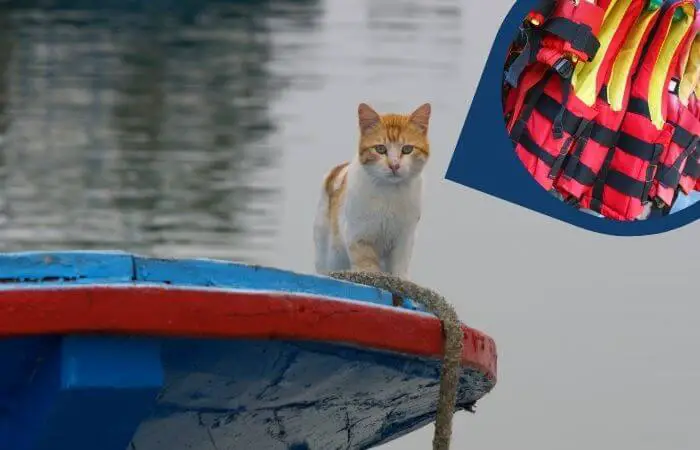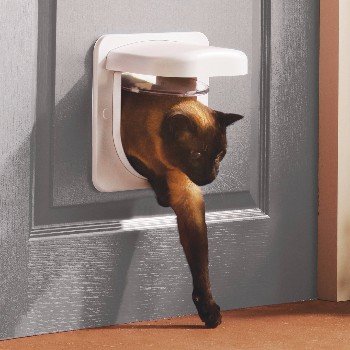Just like people, cats are individuals and they each enjoy different things.
Although it’s commonly believed that cats hate water there is a large number of them that enjoy being in and around water.
More than this, there are many cats that actually live on boats!
Whether you want to bring your cat on the occasional boat trip or you are ready to introduce your cat to life on the sea, this guide will help make boating with cats as safe and smooth as possible.
Contents
Recall Training
Before you set off on any adventures, take the time to teach your cat a few of the basics. In particular, it can be very helpful to train your cat to come to you when you call them.
This way you can quickly get your cat where you want them to be if there is an emergency.

It will also come in useful when you aren’t sure where your cat is (there are lots of nooks and crannies on a boat and it can be easy to overlook your cat taking a nap in one of these hideaway spots).
Basic recall training can make all of the difference when boating with your cat.
Also, make sure you have your cat microchipped with all of your contact information up to date.
This will help increase the chances of finding them if they were to get lost on land when the boat is docked.
Make Sure Your Cat Has A Life Jacket
There’s no denying that spending time on the water is a fun adventure with so many benefits but don’t forget that it can also be dangerous.
You can help keep your cat safe by investing in a cat life jacket. These inexpensive jackets make all the difference if your cat ever goes into the water.

A quality pet floatation device will make sure your cat’s head stays above water if they fall in and the best options have a sturdy handle positioned between the shoulder blades that will make it easier for you to pull your cat back on board if they need assistance.
A proper fitting pet life jacket will support your cat by keeping them afloat and will help them experience less fatigue when in the water.
Even if your cat is able to swim, a life jacket is a must.
Pet-Proof Your Boat
Before you bring your cat on board, go around and pet-proof everything.
Keep all clutter to a minimum and make sure any objects that are hazardous are securely stored out of reach.

This includes storing hooks, lures and other kit out of the way.
Think about places your cat may go to hide and close up any out-of-reach or dangerous holes.
Introduce Your Cat To The Boat Slowly
With so much to see, do and explore on a boat it’s best to give your cat time to get used to the new surroundings so you don’t overwhelm them.
Make sure you give your cat plenty of chances to explore and get comfortable on the boat before you leave the dock.

Introduce your cat to the boat by putting a cat harness and leash on them and showing them around, be aware that ideally your cat should not wear a harness for more than two hours at a time.
Show your cat around the deck and the cabin so they can familiarise themselves with the layout and the different areas.
There are lots of places in the cabin that are perfectly suited for cat naps so this is likely to become one of your cat’s favourite hang-out spots.
For these first few visits to the boat keep the time there short and sweet, don’t stay overnight and don’t leave the dock.
This will help your cat become familiar with the boat without feeling stressed or anxious. Keep them on their leash so they stay close to you and they can’t run off if they get worried.

If your cat seems unsure on the boat, give them time to acclimatise to the new surroundings. If your cat doesn’t seem very confident, bring them on board a few times while rewarding them and playing with their favourite toys etc. to see if they become more comfortable on the boat.
Once they seem comfortable, you can set off on your first boating adventure. If you can, keep the first few adventures short to give your cat time to acclimatise to how the boat feels when it is moving.
Keep Your Cat On A Leash
As mentioned above, it’s recommended you walk your cat on a leash when on the boat, particularly during this delicate introduction process.
You don’t know how your cat will react to all these new experiences so keeping them on a leash will help keep them safe and prevent them from trying to bolt and hide in inaccessible spaces on the boat.
It will also reduce the stress for you as you won’t be worried about where your cat is.

When your cat is used to being on the boat you can decide your own preferences regarding when your cat needs to be on a leash and when they don’t.
Just make sure you always keep an eye on where your cat is and keep them in their life jacket when on the deck to help prevent accidents.
Introduce Your Cat To The Water
Preparing your cat for potential situations will help you handle emergencies more effectively. Knowing your cats swimming ability and comfort level in the water is essential before you set off.

Once your cat is used to wearing their life jacket you can begin introducing them to water (starting with a small, calm pool of water such as a bath).
You can then build up to introducing them to larger areas of water.
Remember, swimming uses a lot of energy so keep any swimming practices short. This is an exercise to get your cat used to being in the water with the life jacket on and it will let you know how comfortable they feel in the water and their swimming ability.
If your cat does enjoy swimming, consider putting a rope ladder on the side of the boat so if they do go for a swim they can get back onto the boat themselves if they want to.
Be sure to show your cat how to use it and test them on it so they know there is a way they can get back on the boat. Also, keep a long-handled net on board in case you need to get your cat out of the water when they are just out of arm’s reach.
Secure The Cat Bed & Litter Tray In Place
As you will be aware, being on a boat can feel unsteady at times.
To help make the daily routines easier it is essential to secure your cat’s bed and their litter tray in position.

You might find it easiest to wedge the litter tray between items so it doesn’t move or you can secure it in place with some strong velcro. It is also advised you use a litter tray with a hood so everything stays contained.
This is not only beneficial for your cat but also for you and the boat’s interior.
You’ll also want to place food and water bowls onto a slip-proof mat to help keep them in place. If you can, bolting or securely attaching a scratching post in position is a good idea too.
Create A Safe Indoor Space
The boat needs to be a comfortable place for your cat if they are going to enjoy boating trips. One of the top things you can do to help this happen is create a kitty hiding place that has your cat’s favourite blankets, toys, treats etc.

This should be a quiet place that your cat knows is their own.
Bringing items such as bedding, blankets and toys from home onto the boat will help the boat feel more familiar.
Be Aware Of Their Health: Cats Can Get Seasick
Cats can suffer from seasickness so this is something to watch out for.
An occasional bout of seasickness is relatively common and nothing to worry about, but if your cat suffers from it regularly it may be a problem.

If your cat does suffer from motion sickness, there are medications available that can help your cat feel better. Speak to your vet about this and keep the medication in your onboard pet first aid kit.
Seasickness affects different cats in different ways so some cats hardly experience it while others are prone to it and may not be cut out for life on the water.
Signs Of Seasickness Symptoms In Cats:
- Vomiting
- Excessive drooling
- Licking their lips and smacking their lips together
- Whining
- Uneasiness/ suddenly stopping an activity
- Yawning
- Disorientation
Plan Your Provisions
It’s important to plan ahead and make sure you have everything you need packed.
Make sure you have enough food, water and cat litter as well as a cat life jacket, pet first aid kit and your cat’s pet passport/ the appropriate up to date documentation for your trip.

Other things to take with you for your cat’s boating trips include a carrier, harness and leash, snacks, scratching post and newspaper/ pet towels.
Before you set off on a trip, get your cat health checked at the vets to make sure all necessary medications and vaccinations are in place.
Whenever you travel elsewhere, always know where the nearest vet is located in case of an emergency.
Be Aware Of International Travel Restrictions
Each country has its own laws relating to bringing pets across borders.
It’s important you know what the rules are before you go to each country so you can be sure you have everything you need for your cat to be allowed in too.
This prior planning and research is essential for a successful trip.
As well as the travel restrictions, take into account the related costs of bringing your cat to certain countries, how long the process takes and whether or not there is a quarantine period.
Safety Tips
- Keep fishing gear out of your pet’s reach – hooks and lines can be dangerous
- Always know where your cat is
- Make sure your cat has a properly fitting life jacket
- Monitor the deck’s temperature to avoid your cat burning their paws
- Have fresh water available at all times
- Always make sure your cat has shady areas available
- Don’t tie your pet to the boat – if you need to restrain your pet use a harness and leash or put them into their carrier
- Know the signs of seasickness in pets
- Keep a large net on hand for rescuing your cat if they fall into the water
Don’t Force Your Cat To Go Boating
If you’ve gradually introduced your cat to the boat and have taken them on a couple of short trips but they don’t seem to be comfortable with it then boating might not be for them.

Some cats prefer to have their paws on dry land and that’s okay too.
If your cat really isn’t enjoying the boat then it may be best to leave them with a sitter during your trip.
Providing seasickness isn’t an issue, many cats respond well to having new experiences introduced to them in slow and positive ways.
Take your time and be patient with them while you introduce them to boating and it will pay off in the long run as your cat will feel confident and comfortable during your water-based adventures.
As an Amazon Associate I may earn a small fee from qualifying purchases at no extra cost to you. This helps us run the site, so thanks for your support!








Leave a Comment